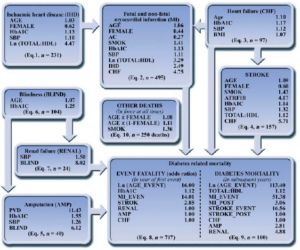A Brief History of Diabetes Simulation Modelling and the Mt Hood Challenge
May 17, 2016

This was replicated a few years later with more modelling groups joining the challenge to compare and validate the results of their simulation models. Since then meetings have been hosted by researchers at Basel, Lund, Oxford, John Hopkins and Stanford Universities. The Mt Hood Diabetes Challenge has now become a bi-annual conference devoted to the economics of diabetes with an emphasis on simulation modelling.

United Kingdom Prospective Diabetes Study (UKPDS) Outcomes Model (for more information, visit https://www.dtu.ox.ac.uk/outcomesmodel)
The ongoing need for a dedicated conference remains, as health economic simulation models in diabetes have to capture the progression of a complex disease, in which multiple risk factors (including blood glucose and blood pressure) can impact on a wide variety of health outcomes including myocardial infarction, renal failure and blindness. Modelling the progression of diabetes and its complications forms the basis of most cost-effectiveness analyses of interventions to prevent and treat both Type 1 and Type 2 diabetes.
Since the first dedicated diabetes simulation model was developed by Richard Eastman back in the mid-1990s, many health economists have worked on computer simulation models for both Type 1 and Type 2 diabetes. Mt Hood provides an opportunity for these groups to test and cross validate their models against each other as well as validate them with real world data. For example, the 5thMt Hood Challenge held at Lund University involved eight modeling groups, who were given four challenges. Most of the challenges at this meeting involved replicating the results of major diabetes trials including ADVANCE and ACCORD. Model outcomes for each challenge were compared with the published findings of the respective trials.
This international conference now involves around 80 participants from a wide variety of backgrounds and allows simulation modelers to interact with those using models for economic and policy analysis. In addition to challenge sessions, the conference accepts abstracts to allow a wide variety of researchers undertaking work on economics aspects of diabetes to present their work.
A major focus of the next challenge, which will take place in September 2016, will be to look ways to make simulation modelling more transparent and reproducible. An aim of the conference is to develop guidelines to promote transparency in simulation. The 2016 Mt Hood Challenge meeting will take place in St Gallen Switzerland in September 16-18.
Do you have any recommendations for transparency and reproducibility as it relates to simulation modeling? Let us know.
~Written by Prof Philip Clarke, Centre for Health Policy, University of Melbourne (Philip.clarke[at]unimelb.edu.au).






